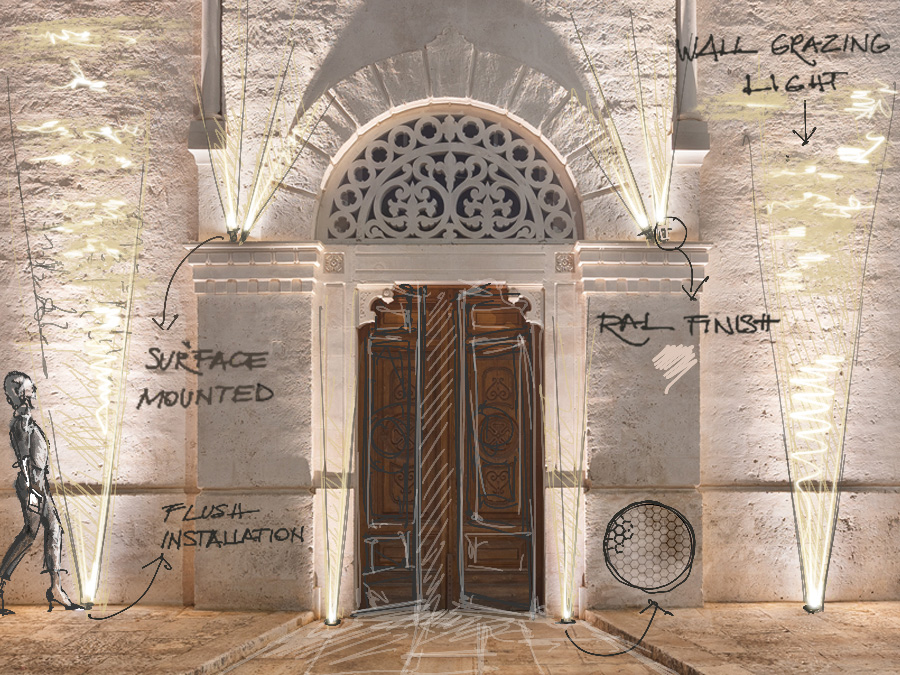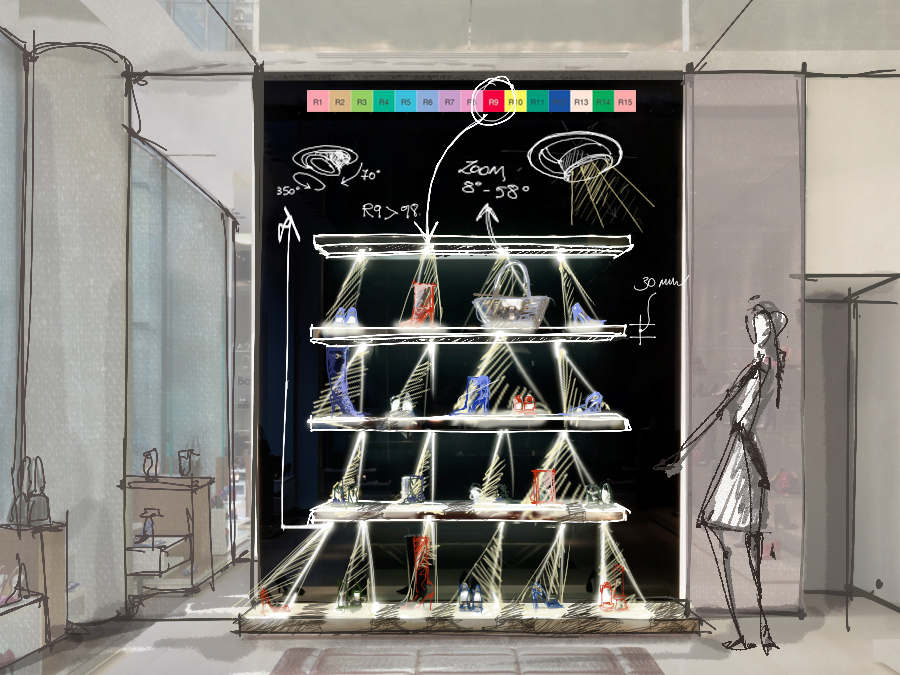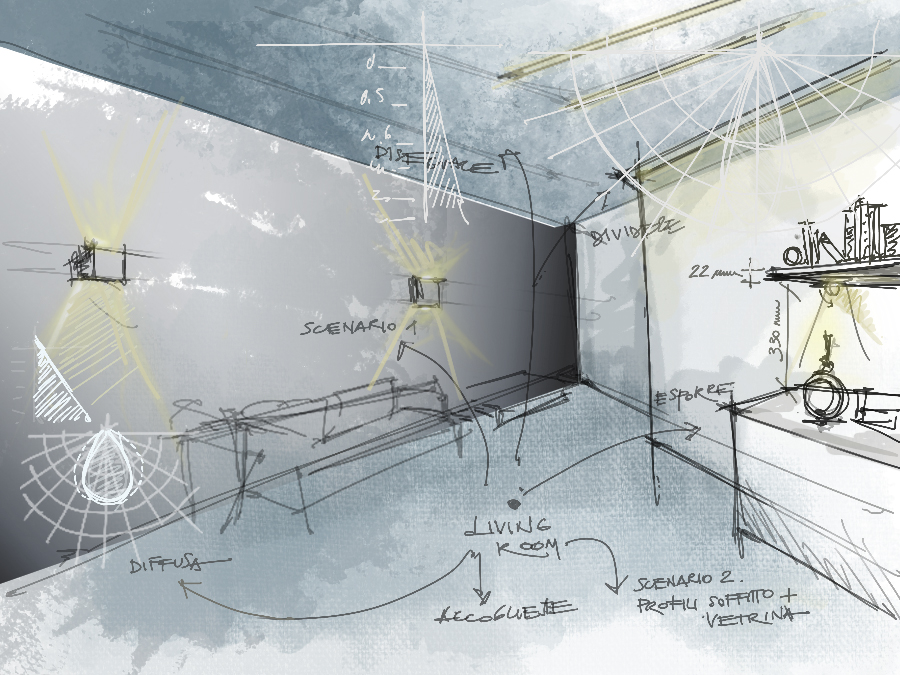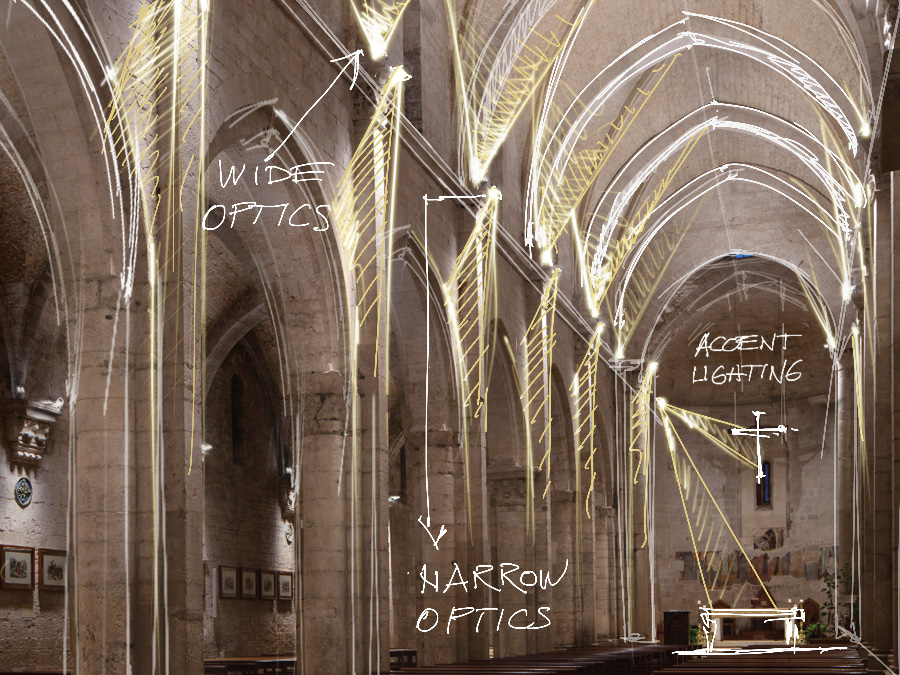To set foot in a church is to find oneself catapulted into a reflective, introspective dimension far removed from everyday life. Time stands still, and we find ourselves permeated by an aura of sanctity, no doubt thanks in part to the incense that fills the air :-)
We asked ourselves how light contributes to creating this august atmosphere that is common to all places of worship, even though they differ so much from each other in respect of religion, age and culture.
🏛 ⛪️ 🕌 🕍
We are based in Italy, the country with the highest number of Catholic cathedrals in the world1, so it is only natural that our experience of lighting mainly, though not exclusively, involves Catholic edifices.
In this article, we’ll be visiting these places inside and out, and top to bottom, and by the end you’ll see them in a new light.
Spaces where social, urban and spiritual matters intersect
One case study we are particularly fond of is the Grand Çamlıca Mosque in Istanbul, for which we created some pretty unusual lighting fixtures in 2018. Their form is highly symbolic for the interaction between man and mosque. In the large courtyard in front of the structure, along its right side and in the esplanade, squares outlined in diffuse light mark out the large paved surface in a rigorously geometric pattern.
The light emitted by the profiles brings this large area to life, welcoming not only the faithful but also tourists and visitors. The squares of light assume an unexpected “interactive” function, becoming the ideal setting for photographs, a sort of luminous podium with the magnificent view of the mosque in the background.
An ambitious lighting design, whose goal was to create a meaningful experience outside the space dedicated to silence and prayer.
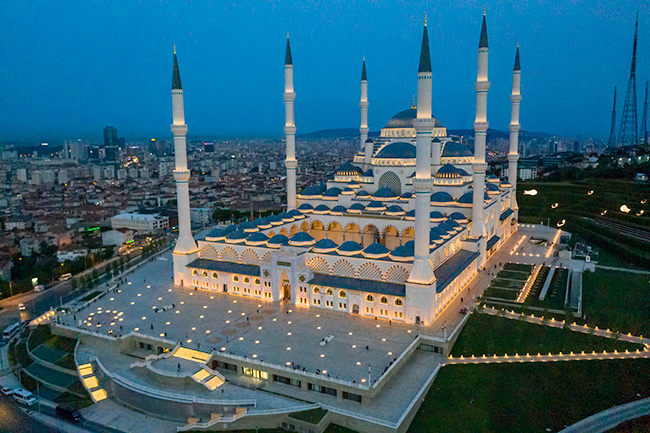
Rio 2, 19W/m, version with customized installation and 2200K colour temperature Go to the project and credits
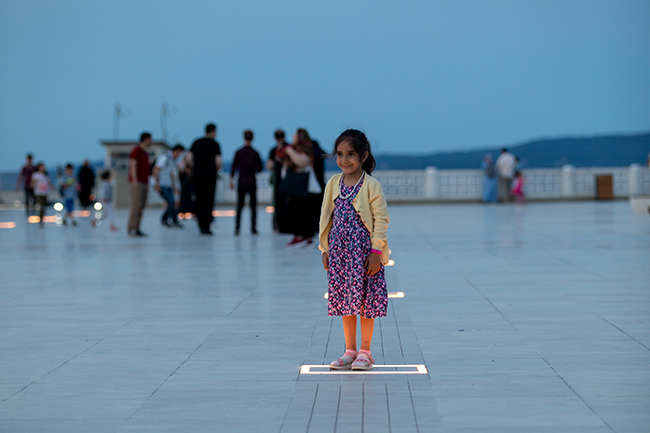
Rio 2, 19W/m, version with customized installation and 2200K colour temperature Go to the project and credits
Looking at the images, it is easy to spot a similarity with Catholic places of worship. This is the parvis, the consecrated ground in front of the main entrance, usually separated from the surrounding public areas by architectural solutions such as steps or balustrades. Today the parvis is used to greet the faithful: it’s where they gather and exchange pleasantries, generally after the service.
The images below show the lighting in the atrium and colonnaded quadrangle of the Basilica of Sant’Ambrogio in Milan. Here, the lighting was concentrated in the cloisters and towards the atrium, through the installation of wall-mounted fixtures with asymmetrical optics directed towards the centre of the colonnaded quadrangle.
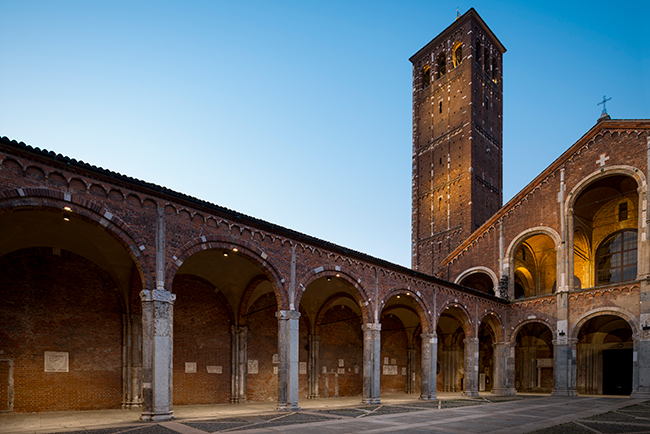
Geko 5.1, 3000K, asymmetrical optics, customized version with 13W power and RAL red finish Go to the project and credits
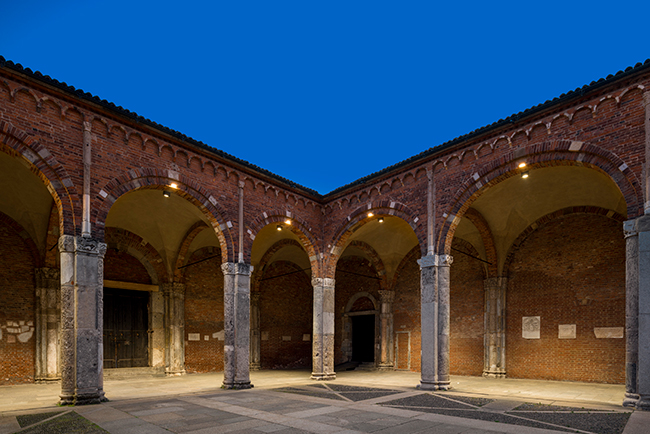
Geko 5.1, 3000K, asymmetrical optics, customized version with 13W power and RAL red finish Go to the project and credits
Whether lit by a “graphic” floor light or a general functional light, in both examples we note the symbolic importance of a transitional space, both physical and mental, to prepare for worship.
Face to facade
We next find ourselves standing in front of the external architectural skin of the place of worship, made up of portals, stained glass windows, pilasters or arches and topped by domes or bell towers, depending on the architectural style.
It is the elements that make up the facade that help us identify the perceptual hierarchies and outline the lighting approach.
Here, we are in Puglia, in the south of Italy, in front of a small church made of tuff and limestone.
The facade is simple, enhanced by a lunette above the architrave. The building material is the principle element here, and worthy of highlighting.
In this case, grazing lighting was chosen. It was achieved with four medium- and low-power fixtures recessed into the ground, and four projectors resting on the architrave and directed at different points of the upper central section. The stone’s porous texture is accentuated, and its very pale colour seems to reflect indirect light onto the church courtyard; the scene is framed by the elegant lines of the cornices.
Moving on a little, we are in Abruzzo, outside another small, historic church, similar in some ways, where it was decided to use light in a different way.
In this case the choice was not to highlight the stone but to draw attention to the hollows of its characteristic architectural elements. Concealed recessed spotlights were therefore installed in the stone architrave of each door to light the entrances, while projectors with 10°x180° optics were mounted on the outer frame of the rose window and at the base of each niche and lunette to emphasise the internal profiles of the arches.
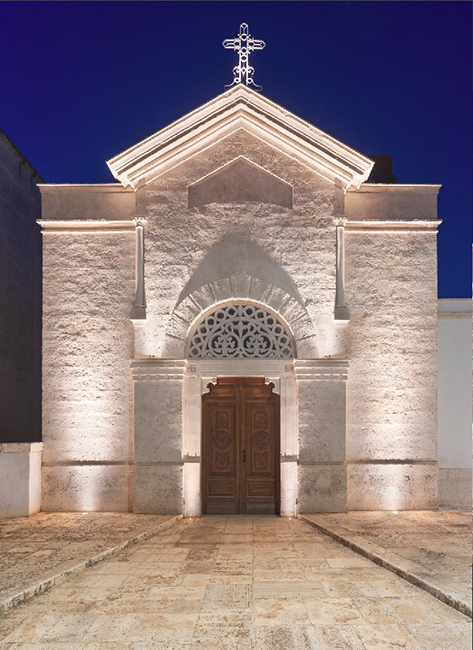
Bright 1.0, 3000K, 2W, 20°, with honeycomb louvre / Bright 3.F, 3000K, 10W, 21° / Pivot 1.7, 3000K, 7W, 34°, anodized grey Go to the project and credits
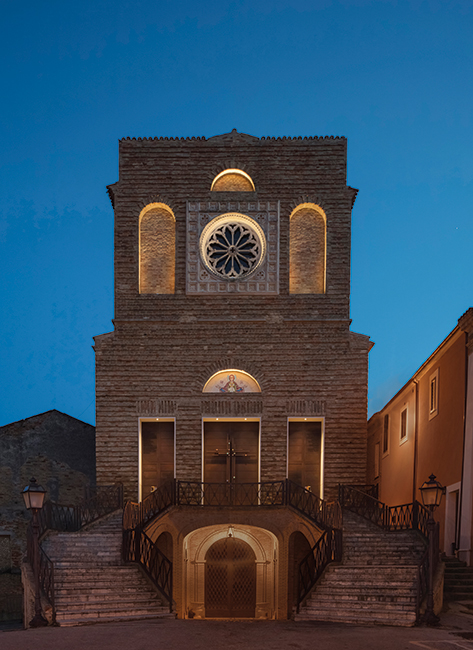
Litus 2.4, 3000K, 7W, 13x52° / Lyss 1.0, 3000K, 5W - 7W, clear 10°x180°, white Go to the project and credits
The Soprintendenze per i Beni Architettonici e Paesaggistici (the departments of architectural heritage and landscapes) are responsible for the protection of Italy’s cultural heritage, so they often restrict the scope of work on historical facades. In most cases, drilling is kept to a minimum by using projectors fixed with brackets and running their cables along the architectural elements. From an aesthetic point of view, being able to paint the lighting fixtures with an exact RAL colour means the devices can blend into the facade or structure, reducing their visual impact.
Finally, we have two examples of facades where the choice was made to draw attention to the high walls.
The first photo shows a modern church where the curved wall is “washed in light” along its full width by linear profiles recessed into the ground and fitted with wall washer optics. They produce a soft, welcoming light, with no harsh shadows, that gives volume to the structure.
In the second, the linear profiles house narrow optics and are positioned at the base of the pilasters, lending solemnity to the facade as it soars towards the sky.
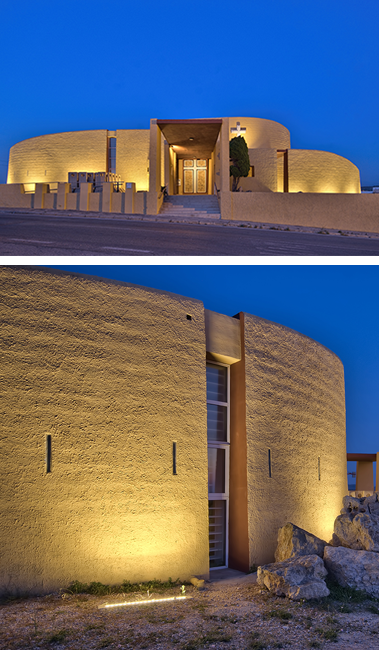
River 2.1, 2700K, 40W Go to the project and credits
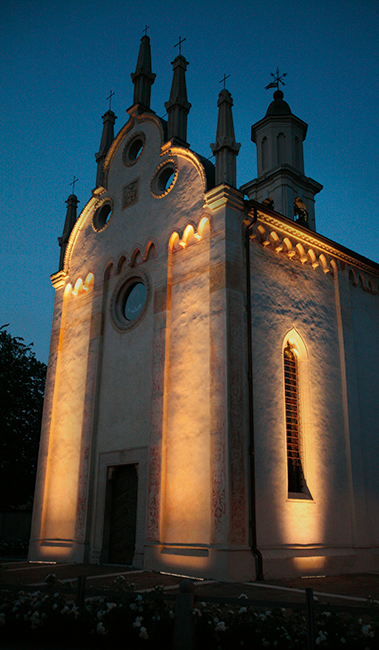
Neva 1.2, 3000K, 45W, 11° Find out more about the product
Sculptural facades
Let’s now look at other components that comprise and characterise the facade. A frequent feature on exterior walls is statuary.
If, to accentuate these statues, we place a lighting fixture close to the wall, exactly beneath the figure, the light emitted creates a strong chiaroscuro contrast, giving it an air of drama (see the first photo).
To achieve a softer effect, we can move the light source further away and opt for asymmetrical or adjustable optics, whose output lights the sculpture more softly and uniformly (see the second photo). A diametrically opposite effect is obtained by placing a light behind the statue: this leaves the statue in silhouette, with only its contours discernible in the backlight (see the third photo).
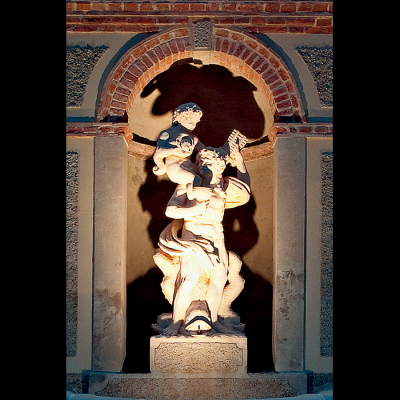
Spot 3.4, 3000K, 15W, 39° Find out more about the product 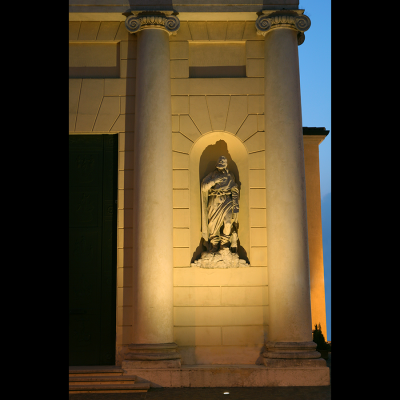
recessed, 3000K, 10W, stainless steel 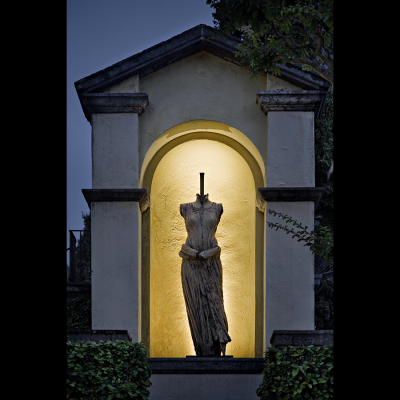
Spot 1.6, 2700K, 2W, 40° Go to the project and credits
Friezes and bas-reliefs are recurring architectural elements that are easier to illuminate from a distance than close-up.
In the case below, projectors were mounted on poles in the cathedral square to pick out the three bas-reliefs and the rose window on the facade. The very narrow 6° optics light these elements and bring them to the fore. This solution also entirely avoids drilling into the facade.
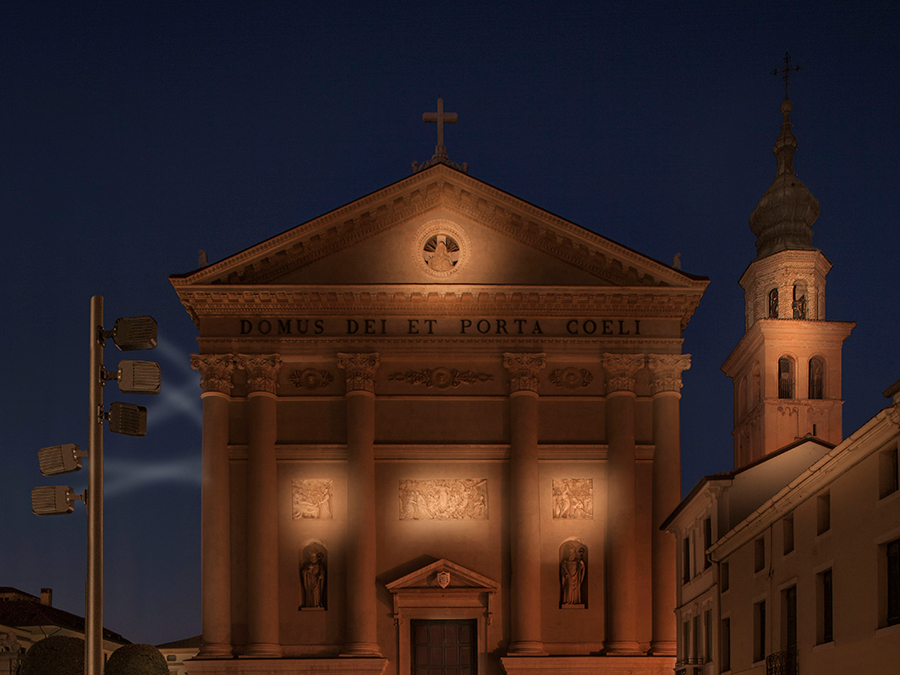
Siri 2.0, 3000K, 6°, anthracite Find out more about the product
The final sculptural element we want to reflect on is the rose window, the circular window that dominates many facades on western churches from Romanesque and Byzantine times onwards.
Lighting the internal profile of these elements requires a fixture that emits light at 180°, so that the light output is concentrated on the internal reliefs and emphasises their forms. The light emission can have softer contours if frosted optics are used, or more defined ones if transparent optics are chosen.
Frosted optics can reduce the contrast between light and shadow, something that is particularly worth considering with a decorative motif.
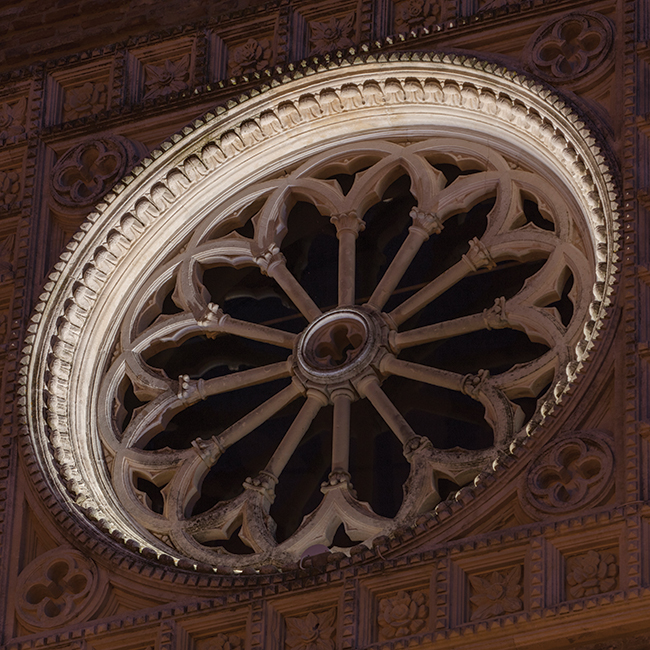
Lyss 1.0, 3000K, 5W, clear 10°x180°, white Go to the project and credits
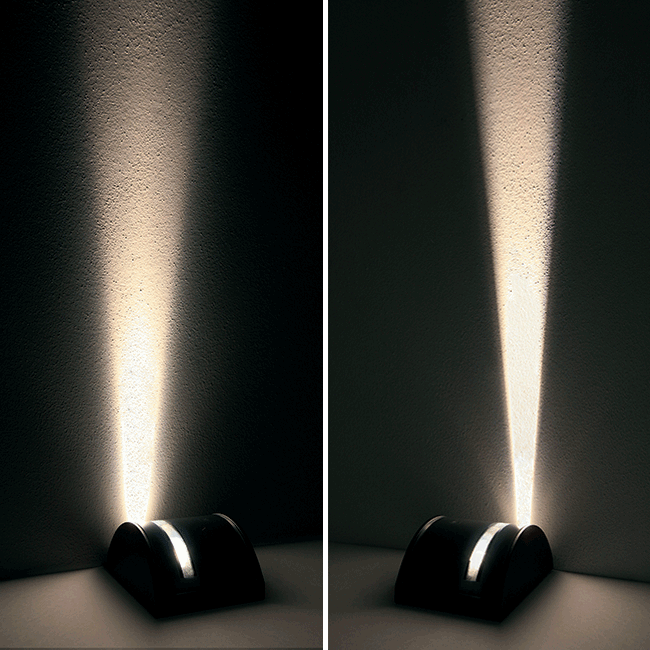
Lyss 1.0, with satin optics 20°x180° / Lyss 1.0, with clear optics 10°x180° Find out more about the product
One step away
Having discussed lighting the shapes and elements visible looking up at a church facade, we’re moving closer, our gaze dropping as we do so, until we are just a step away from entering. Now, as we watch where we put our feet, we’re looking at the entrance.
Installing two small, recessed fixtures in the paving directs the gaze to the entrance and a majestic doorway, which is why it is advisable to have the honeycomb louvre built into the lighting fixture, to protect visitors from glare.
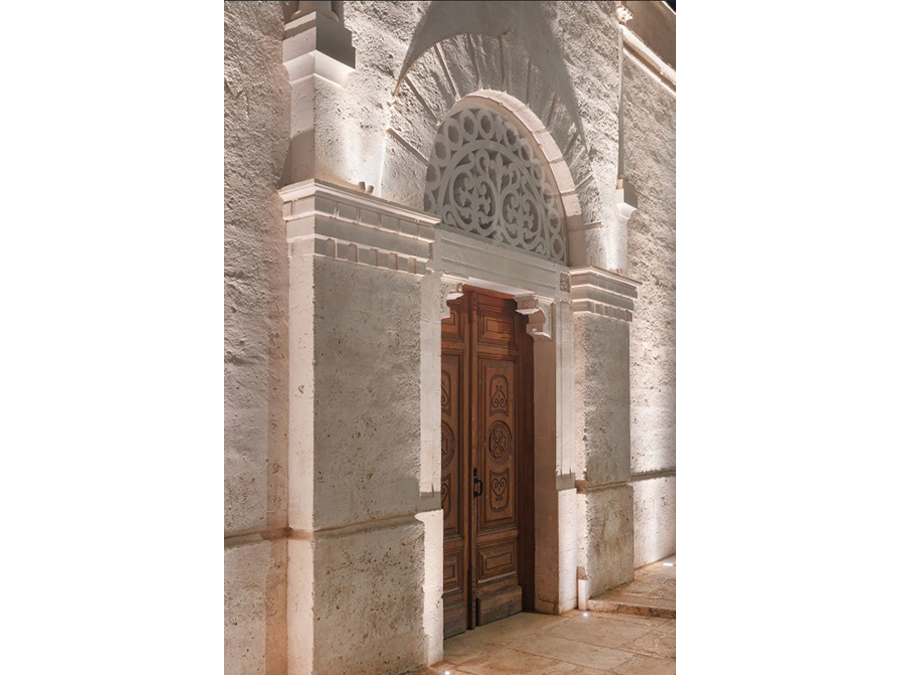
Bright 1.0, 3000K, 2W, 20°, with honeycomb louvre / Bright 3.F, 3000K, 10W, 21° / Pivot 1.7, 3000K, 7W, 34°, anodized grey Go to the project and credits
Otherwise, the entrance can be lit using top-down lighting, for instance with recessed fixtures installed in the stone architrave.
In the case study below, the choice of elliptical optics made it possible to outline in light the intrados of the entrances and to accentuate the relief decorations on the entrance doors.
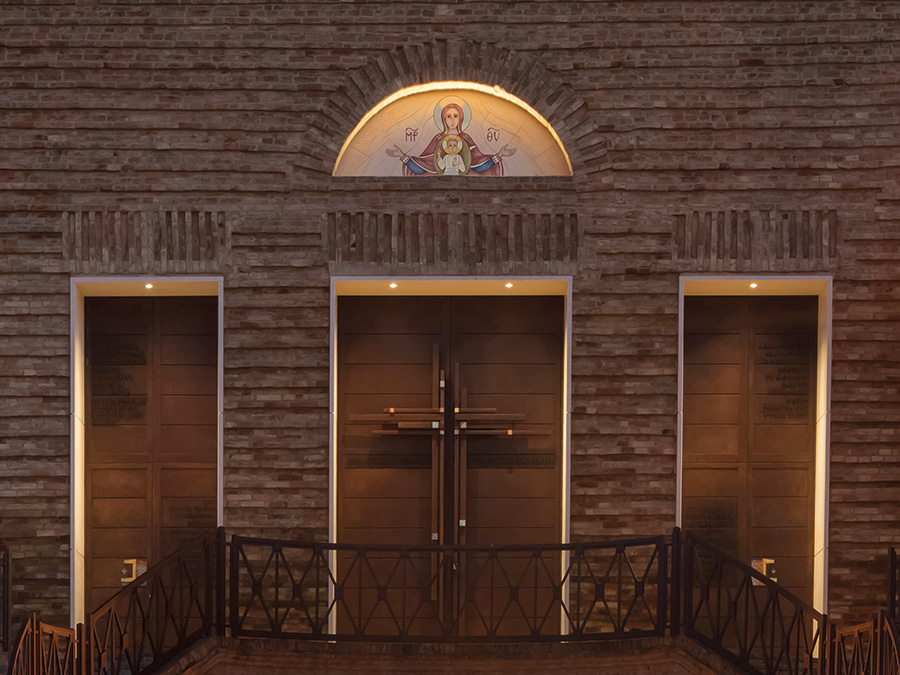
Litus 2.4, 3000K, 7W, 13x52° Go to the project and credits
We can hear the bells ringing, it’s time to bring this first part to a close.
If we turn our gaze to the belfry, we see its contours traced against the midnight-blue sky by 10°x180° optics, while the majolica cladding is enhanced by small projectors at the top with 40° optics. Among the roofs and walls of the village, lit by the yellowy-orange light typical of high-pressure sodium lamps, a bell tower lit with a colour temperature of 4000K stands out above the rest.
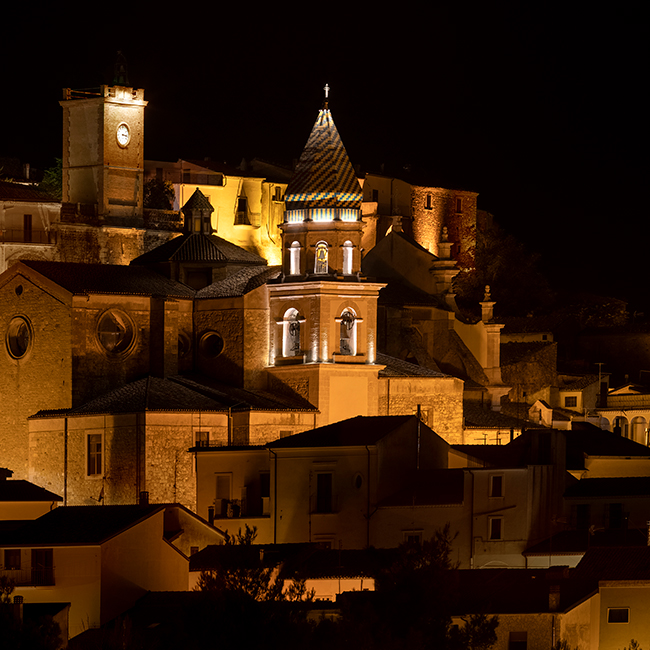
Lyss 1.0, 4000K, 7W, 20°x180°, white / Spot 1.0, 4000K, 2W, 40° - 10° / Trevi 1.1, 4000K, 21W, diffuse Go to the project and credits
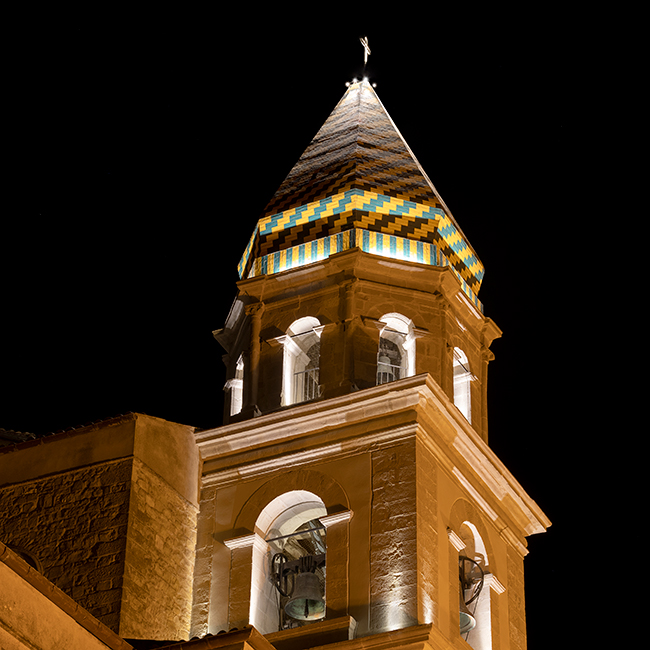
Lyss 1.0, 4000K, 7W, 20°x180°, white / Spot 1.0, 4000K, 2W, 40° - 10° / Trevi 1.1, 4000K, 21W, diffuse Go to the project and credits
Simultaneously, in France, the bells of the small village of Vieuvicq in lower Normandy chime in. Although the church here is lit entirely with LED technology, the lighting has the same warm colour.
The structure is lit by projectors with 2700K white light, while a bold 5000K white light has been used for the bell tower. At the point where this ecclesiastical architecture is closest to God, cool blue tones colour the lighting.
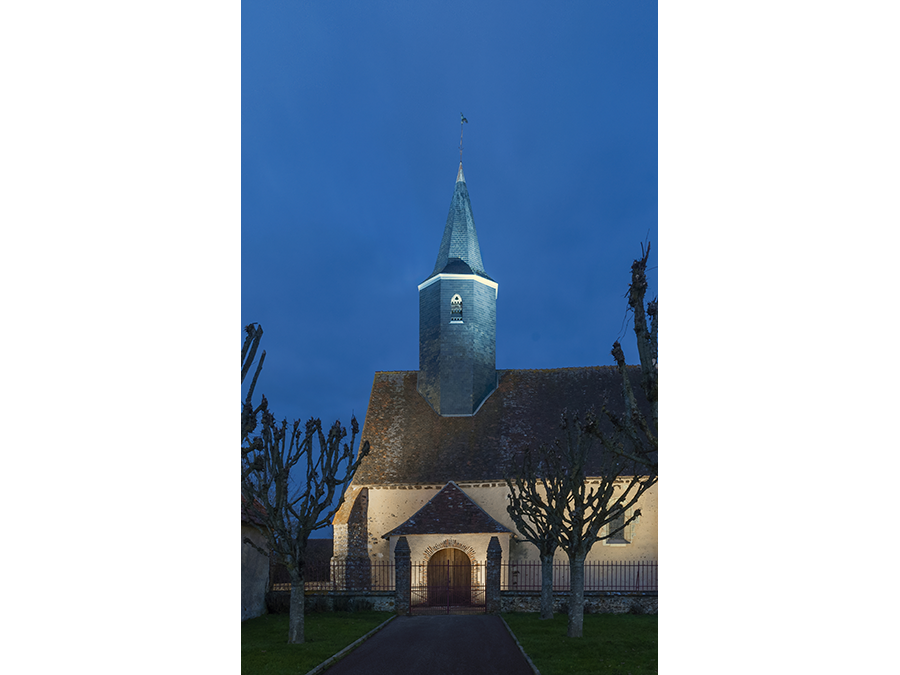
Siri 3.0, 2700K - 5000K, 23W, 30° - 6° - 12° Eglise Saint Martin, Vieuvicq, France
In this article, we have looked at places of worship from the outside, focusing on the elements that make up the facade, passing across the parvis and looking up towards the bell tower.
In the next post, we’ll look at the light that vitalizes the spiritual atmosphere from the inside.
Bibliography
1: Gcatholic, http://www.gcatholic.org/churches/cath.htm, 02/02/2021
Have you used our fixtures to light the exteriors of a place of worship? What are you waiting for ...

